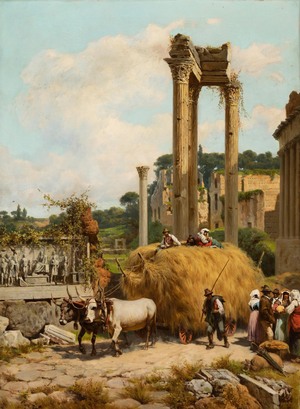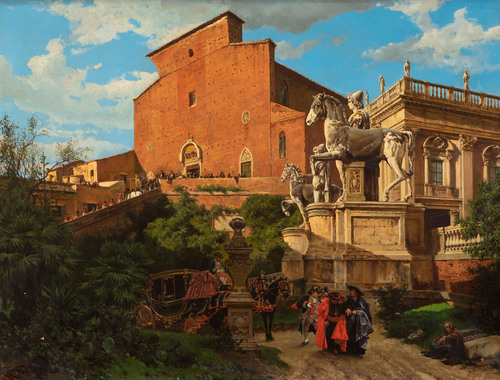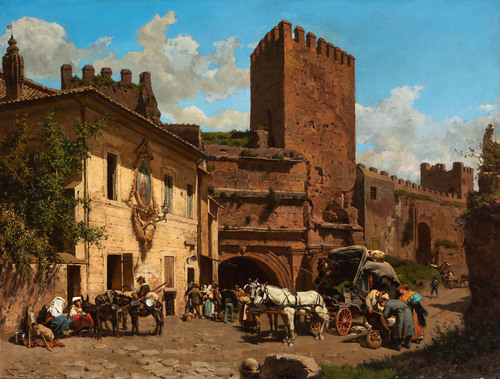Ramón Tusquets, an artist who makes Italy the cradle of his art
The Neapolitan and Roman countryside, as well as daily activities in beautiful towns in southern Italy, and also in its capital, inspired some of the best works of Ramón Tusquets.
We confirm this with three important oil paintings that these days can be purchased at Setdart Auctions. Both belong to the period of greatest recognition of Tusquets, as shown by the fact that at the time he painted them (in the last decade of the 19th century) he was presiding over the International Artistic Circle of Rome.
See “Procession Day” (lot 35252587 ), a splendid canvas in which our gaze is entertained, lingering over each visual line of a plural narration, rich in details and anecdotes. At the same time, it does not disregard the overall vision, through a scene recreated in depth, where nature and noble stone intertwine. We are probably in a corner of the Vatican gardens, among equestrian statues and papal effigies crowning a neoclassical patrician basilica.
A procession of friars slowly climbs a staircase, escorting the canopy of the Virgin that precedes them. The upper part of the bodies peeks out from behind the red stone parapet, glowing from the lighted torches they carry in their hands. A multitude of figures crowd under the gilded tympanum of the church. Tusquets manages to make us feel the vivid as well as restrained monastic heartbeat , but all this remains in the background, diverting our curiosity to what happens in the foreground: a cardinal appears accompanied by two guards with tricornes and another ecclesiastical figure. Muted words and sideways glances intertwine between the members of this small group. The precious attention paid to the details of the clothing stands out, as well as those of the majestic carriage that awaits them behind them. The precarious clothing of the beggar who begs with his eyes for mercy, sitting by the roadside, reveals by contrast the squandering of fine gold and brocades by the lords.
The painter Ramón Tusquets describes in this composition , rich in anecdotes, the arrival of a carriage in a town, before whose medieval walls with crenellated towers the members of a family alight. Under a luminous sky, the midday sun shapes each of the figures gathered before what appears to be the town hall, with its stately facade of ancient ashlars. Almoners sitting on the cobblestones, travelers and country people enliven the scene.
Ramón Tusquets was a painter with a light palette, who participated in the Impressionist currents of his time and stood out in them for his observant aptitude and the anecdotal realism with which he imbued his scenes. This is also evident in the other canvas that Setdart is offering up for auction: “La Diligence” (lot 35252586), signed in Rome in 1897.
Once again we find ourselves before a composition rich in anecdotes. It describes the arrival of a carriage to a town, before whose medieval walls with battlemented towers the members of a family alight. Under a luminous sky, the midday sun shapes each of the figures gathered before what appears to be the town hall, with its stately facade of ancient ashlars. Moss covers some battlements. Almoners sitting on the cobblestones, landowners, travelers and country people enliven the scene, distributing themselves in groups that seem to come and go spontaneously, transmitting the freshness of character of humble people.
Ramón Tusquets (1837-1904) traveled to Italy at an early age and by his own means, a country where he would reside for the rest of his life. After a year’s stay in Rome, where he studied at the Chigi Academy and joined the circle of Catalan painters living there, he appeared for the first time at the National Exhibition of Fine Arts in Madrid (1867), being awarded the third medal. class. He also took part in the Barcelona Exhibition that same year, where he presented the work “Kitchen”, which was acquired by the Diputación. Oriental themes, directly influenced by the work of Fortuny, and views of the countryside and the outskirts of Rome are frequent in his production during this period. In 1869 he traveled through Andalusia with the Italian Pio Joris, taking notes for compositions such as “El requeebro”. In 1871 he sent a work from Rome to the Nacional, being awarded the second medal. Starting in 1872, he became deeply friends with Fortuny, and together they undertook a trip to Naples. There they will learn about the latest trends of the Portici group and, in particular, they will be interested in the work of Domenico Morelli. Tusquets is currently painting landscapes of Naples and Amalfi, specializing in rural landscape compositions with figures dressed in traditional costumes. On Fortuny’s death, he reproduces his burial in an impressive painting, where the influence of the “macchiaioli” can be seen.
In 1875 he will exhibit several paintings at the International Circle in Rome, being highly praised by Italian critics . In 1877 he was awarded the diploma of honour, the only one reserved for foreigners, at the Naples Exhibition, and the Italian Government acquired the work. During these years his works are exhibited in numerous European cities, being awarded at the Universal in Vienna (1876) and Paris (1878). In 1880 he exhibited for the first time in the Parés room in Barcelona. Definitively installed in Rome, Tusquets is named president of the International Artistic Circle of the city. With his works from the 1980s, he established himself in the official historicist genre, so far removed from the simple compositions of his earlier stages. During his last years he will deal with a wide range of topics, capturing both orientalist scenes as well as customs and historicists. He is represented in the Prado Museum, the MACBA in Barcelona, Montserrat and the National Art Museum of Catalonia.








